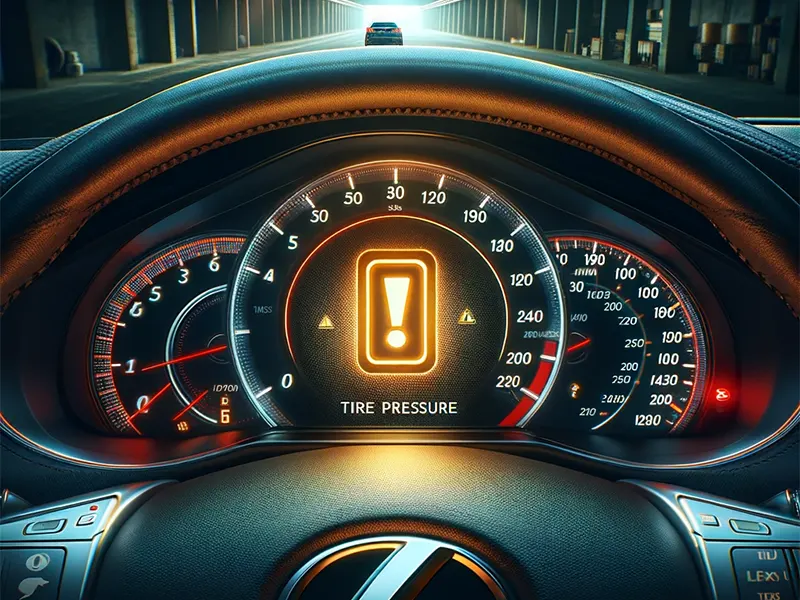he amber glow of the tire pressure warning light staring back at you from your Lexus dashboard might seem like a minor annoyance, but it’s your car’s way of whispering a crucial safety message.
Heeding this silent plea can save you from a potentially dangerous blowout or compromised handling. But what if your tires are demonstrably full? The answer lies in the intricate workings of your Tire Pressure Monitoring System (TPMS).
What’s TPMS?
TPMS acts as a Guarding system, constantly monitoring the pressure in each tire using dedicated sensors. These sensors transmit real-time data to your car’s computer, ensuring optimal pressure for peak performance and safety. Underinflated tires, even by a few psi, can significantly increase rolling resistance, impacting fuel efficiency and handling. Worse still, they’re more prone to blowouts, putting you and your passengers at risk.
When the Light Speaks: A Constellation of Possibilities
So, the light is on, your tires are full, and you’re left scratching your head. Don’t fret, for this illuminated icon can be a symptom of various tire-related issues:
1. Pressure Discrepancy:
- Temperature’s Tangled Web: Remember, cold weather contracts air, leading to a slight pressure drop. This is especially common in the mornings, so a quick top-up might be all it takes.
- Slow Leaks: Unlike the dramatic hiss of a puncture, slow leaks can be insidious, causing pressure to gradually dwindle over time. Regularly checking your tire pressure is key to catching them before they become a bigger problem.
2. Sensor Mischief:
- Battery Blues: Like any electronic gremlin, TPMS sensors have batteries that can deplete over time, leading to malfunction and false alarms.
- Sensor Trauma: Bumps, potholes, or even clumsy tire changes can damage these delicate sensors, throwing their readings off kilter.
3. System Hiccups:
- Misinformation Mayhem: Did you recently change tires? If the TPMS wasn’t properly reset, it might be using incorrect pressure values, triggering the warning light even with properly inflated tires.
- False Alarm Frenzy: While rare, even the most sophisticated systems can occasionally glitch, leading to a phantom light show. Don’t panic, but a quick system check by a qualified technician wouldn’t hurt.
Troubleshooting Tactics
Before heading straight to the mechanic, try these DIY troubleshooting steps:
- Reinflate to the Right Tune: Invest in a reliable tire pressure gauge and top up your tires to the recommended pressure specified in your owner’s manual (it’s not always the number stamped on the tire sidewall!). Remember, even a slight overinflation is better than underinflation.
- Drive and Reconnect: For Lexus models, a 10-20 minute drive at moderate speeds can allow the sensors to update and potentially reset the light. Consult your manual for specific distances for your model.
- Reset Rituals: Some Lexus models have dedicated TPMS reset buttons or procedures outlined in the owner’s manual. Follow these instructions carefully, but avoid resetting if you suspect a genuine pressure discrepancy.
Advanced Diagnostics and Repair
If the light persists or you suspect a sensor issue, it’s time to call in the pros:
- Tire Sleuthing: Modern Lexuses display real-time tire pressure information on the dashboard, allowing you to pinpoint the culprit tire. If your model lacks this feature, specialized tire pressure scanners can do the job.
- Sensor Savvy: Professional diagnosis will determine if a sensor needs replacing. The process is relatively straightforward, involving removing the faulty sensor, mounting a new one, and re-calibrating the system. Expect costs to range between $50 and $150 per sensor, depending on the model and labor charges.
Remember, a vigilant TPMS light is not a nuisance, but a guardian angel looking out for your safety. By understanding its language and taking appropriate action, you can ensure your Lexus rolls smoothly and confidently down the road. So, the next time that amber beacon illuminates your dashboard, don’t just ignore it – decipher its message and keep your tires, and yourself, happy and healthy.

John Smith, a Los Angeles-based car specialist and automotive writer, boasts over 20 years in the industry. With a background as a master technician and a decade-long writing stint at notable automotive publications, John now shares his expansive knowledge on CarFinite, simplifying car maintenance for readers.

